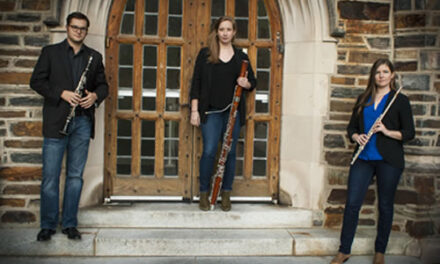This past Sunday, the Chamber Orchestra of the Triangle performed a concert entitled Soundscapes, which the ensemble billed as “exploring the acoustic possibilities of space and time.” Located at the classically beautiful St. Stephen’s Episcopal Church (where the ensemble originated as the congregation’s Chamber Orchestra in 1982), the orchestra presented a program of three works divided into “the secular and the profane,” as said to the masked and vaccinated audience by assistant conductor Niccolo Muti. The first two works on the program, Fantasia on a Theme by Thomas Tallis by Ralph Vaughan Williams and Sogno di Stabat Mater by Lera Auerbach, take inspiration from religious source material. The third and final work, Arnold Schoenberg‘s Verklärte Nacht, is based on a poem of the same name by Richard Dehmel that “tries to depict the human soul in its darkest moments and ultimately celebrate its indomitable capability for redemption,” as quoted from the afternoon’s program notes. The COT took advantage of their homecoming venue; the profound program melded with the stained glass and exposed stone to create a reverential experience.
Vaughan Williams’ Fantasia on a Theme by Thomas Tallis began the concert with an ethereal and sonorous tone as Muti led the ensemble without a baton, shaping the music with his bare hands as the orchestra followed steadfastly. The piece, based on a 16th century English hymn and commissioned originally for performance in Gloucester Cathedral, is arranged for string quartet and double string orchestra; the afternoon’s performance highlighted the COT’s own chamber group in residence, the Verona Quartet. The soloists and tutti sections moved together with great intensity and organically spun the phrases with sensitive blending and nuanced dynamics. The quartet members each had unique soloistic moments, executed with sparkling tone, rich vibrato, and effective communication — melodies were passed around with eye contact and sensitivity, and supporting harmonies only contributed to the primary phrases. When called upon, the tutti orchestra, which was spread out across the altar stairs, aided the quartet with solid ensemble and virtuosic playing. The overall momentum of the work was well-paced and the audience almost dared not to clap as the final note dissipated up towards the ceiling.
Continuing the sacred theme, Auerbach’s Sogno di Stabat Mater is a concerto grosso for violin, viola, and chamber orchestra that “transcribes a sacred vocal work into an abstract instrumental one” in an attempt to highlight “the similarities between cultural and harmonic aesthetics between the 18th and 21st centuries,” according to the composer herself. Auerbach states, “The image of the grieving mother is universal, just as pain is universal, though its expressions may vary according to cultural or religious backgrounds.” This emotional theme is present from the beginning of the work. Conducted again by Muti and featuring violinist Dorothy Ro, violist Abigail Rojansky, and vibraphonist Krista Siachames, Sogno di Stabat Mater‘s delicate harmonics, brutal pizzicati, and ominous ponticello combined with lush sustains and powerful chords to produce a work that combined fervent religious themes with modern techniques and harmonies. The soloists took advantage of their resonant venue and commanded total control over the hall as they drew immense sound out of their instruments and moved together like one organic entity. The accompanimental tempi, articulation, and timbre blended well with the soloists to create an unearthly yet devout effect. When the piece reached its conclusion, the audience lauded the soloists as they congratulated their peers in a humble display of gratitude.
To close the concert, Schoenberg’s Transfigured Night was led by artistic director Lorenzo Muti, who asked that the audience read the source poem printed in their programs before he, too, organically conducted the ensemble without a baton. This piece represents the aforementioned “profane” theme of the afternoon’s program as the poem describes a woman telling her lover she is pregnant with another man’s child. The poem’s conversation depicts the transformation of sadness to acceptance, and Schoenberg’s tone follows a similar trajectory. The ensemble navigated layered entrances with dynamic sensitivity; musical urgency built and dissipated like a light-switch. I could hear the orchestra breathing together and was incredibly impressed with the balance between virtuosic and ensemble playing. The violins executed sparkling high notes with well-blended intonation as the lower voices established a lush core sound, like stars twinkling in the night sky. The ensemble exchanged melodies smoothly across sections, and the overall balance of harmonies amongst inner voices was impressive. The undulating second violin and viola lines flowed under the cello and first violin’s shimmer. As the mode changed from minor to major, the plot of the poem was evident in the orchestra’s sensitive playing. Releases resonantly hung in the air, and by the end of the piece, the audience appeared to be holding their breath before breaking out into a standing ovation. As I was exiting the hall, I heard Lorenzo Muti tell a patron that it was “lovely to be back,” and that sentiment was evident in the Chamber Orchestra of the Triangle’s expressive performance. Bravo to all involved, it was truly a sacred event.












